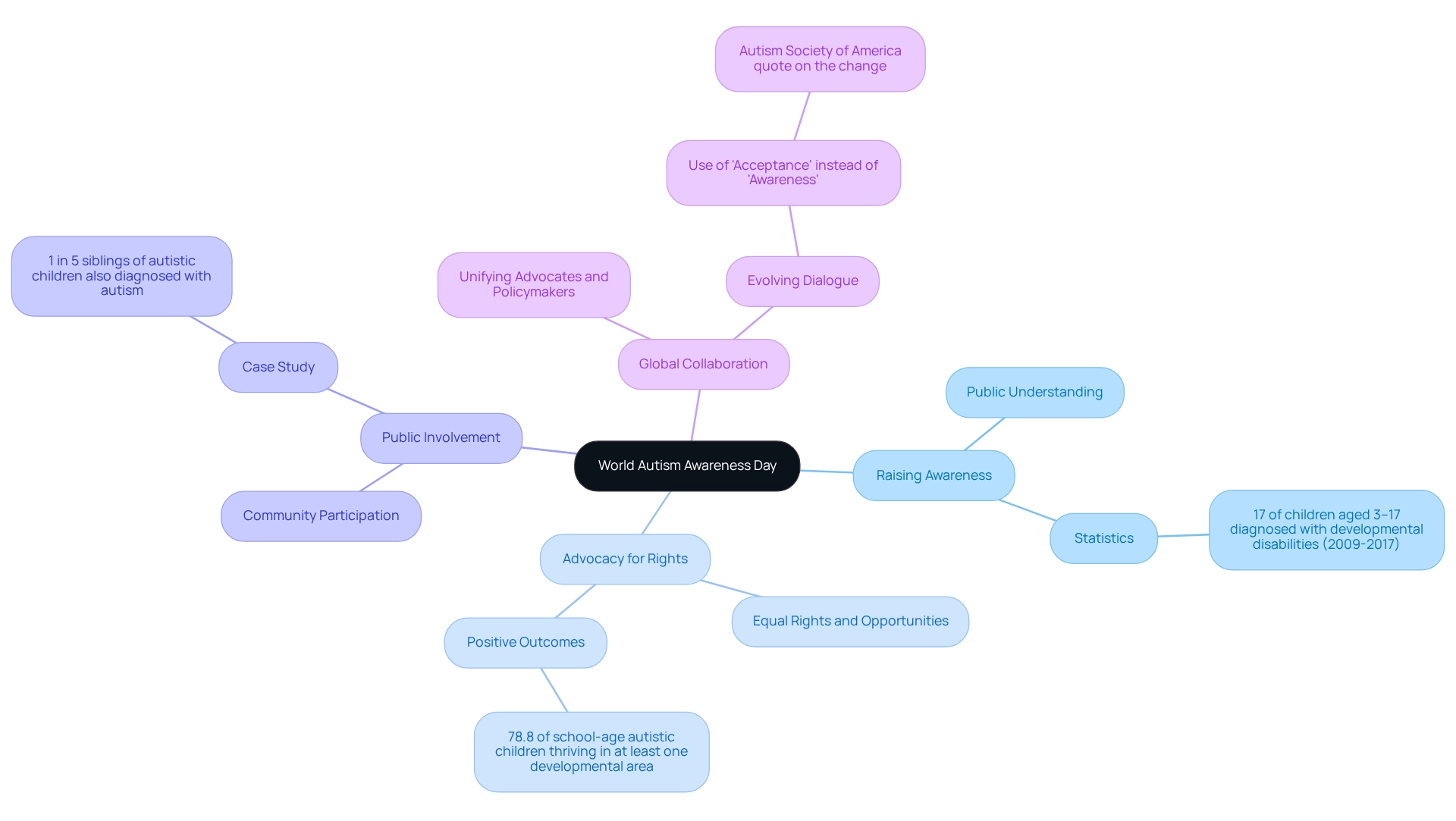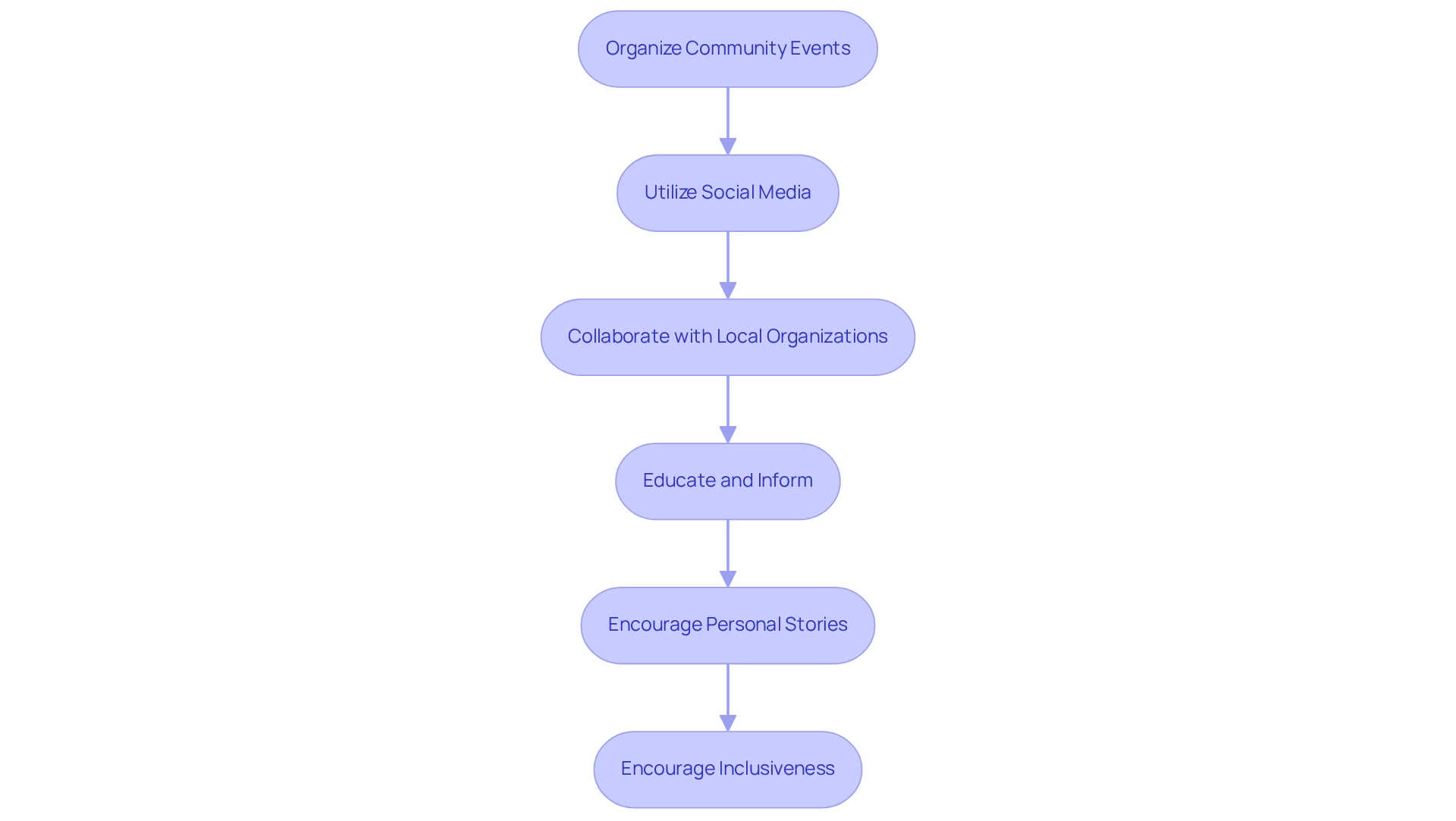Overview
World Autism Day 2024 offers a heartfelt opportunity for advocacy through community engagement, education, and collaboration. It’s a chance to promote understanding and acceptance of autism in a nurturing way. This article highlights meaningful strategies such as:
- Organizing local events
- Utilizing social media
- Encouraging the sharing of personal stories
Together, these efforts aim to cultivate a more inclusive environment and raise awareness about both the challenges and strengths of individuals on the autism spectrum. By coming together as a community, we can foster deeper connections and support for those affected by autism.
Introduction
Autism Spectrum Disorder (ASD) is a complex and diverse condition that presents unique challenges and strengths for individuals affected by it. Understanding the intricacies of autism is essential for fostering acceptance and creating inclusive environments. This article delves into the fundamental concepts surrounding ASD, the significance of World Autism Awareness Day, and effective strategies for advocacy and engagement. By exploring these key areas, readers will gain valuable insights into the importance of awareness, the ongoing need for support, and the transformative power of community involvement in enhancing the lives of those on the spectrum.
Understand Autism Spectrum Disorder: Key Concepts and Challenges
Autism Spectrum Disorder (ASD) is a complex developmental condition that presents ongoing challenges in social communication, limited interests, and repetitive actions. Understanding these fundamental concepts is vital for effective advocacy. Let’s explore several key aspects together:
- Diversity of the Spectrum: Autism manifests uniquely in each individual, leading to a wide range of abilities and challenges. Recognizing this diversity is crucial for fostering acceptance and offering tailored support.
- Common Challenges: Many individuals on the spectrum face difficulties in social interactions, sensory processing, and communication. By understanding these challenges, advocates can help create more inclusive environments that cater to diverse needs.
- Strengths and Abilities: Numerous individuals with developmental differences exhibit remarkable strengths, such as heightened attention to detail and exceptional visual skills. Highlighting these strengths can shift the narrative from one of limitation to one of potential, fostering a more positive perception of autism.
- Importance of Early Intervention: Research indicates that early diagnosis and intervention can lead to significantly better outcomes for children with developmental disorders. Advocates should stress the importance of available resources and support services, ensuring families receive the assistance they need in a timely manner.
By grasping these essential ideas, advocates can engage more effectively with the community, promoting a more inclusive society for those on the autism spectrum. Recent statistics reveal that among children aged 4 years with ASD, the Childhood Autism Rating Scale (CARS) is the most commonly documented assessment tool, utilized in 38% of cases. This underscores the importance of standardized evaluations in understanding and addressing the needs of those on the spectrum. Furthermore, the persistent challenges faced by individuals on the spectrum highlight the critical need for advocacy informed by current research and expert insights, particularly as awareness of developmental disorders continues to evolve in 2025.
Additionally, the financial aspects of services for those with developmental conditions can be significant. For instance, adaptive behavior services cost approximately $82.25, while emergency room visits may reach around $1,397.22. Understanding these costs is essential for families as they navigate available resources. As Zachary Warren, a training consultant for OCALI, noted, the advocacy landscape is ever-changing, making it vital to adapt our strategies accordingly. Moreover, the trend of increased assessments and ASD identification among children born in 2018, which resumed by June 2020 following a disruption due to the COVID-19 pandemic, emphasizes the evolving nature of awareness regarding the condition and the necessity for ongoing advocacy. Advocates must prioritize accessible services and support for families, as highlighted in recent reports, to ensure that all individuals with developmental disorders receive the necessary assistance.
Recognize the Importance of World Autism Awareness Day: Purpose and Impact
World Autism Awareness Day, celebrated every year on April 2nd, serves as a vital platform for fostering understanding and acceptance of autism. Its significance can be encapsulated in several key areas:
- Raising Awareness: This day is dedicated to increasing public understanding about autism, effectively dispelling myths and misconceptions that contribute to stigma and discrimination. Statistics indicate that from 2009 to 2017, 17% of children aged 3–17 were diagnosed with a developmental disability. This underscores the necessity for informed public discourse and highlights the critical role that awareness efforts play in fostering understanding and acceptance.
- Advocacy for Rights: It highlights the pressing need for equal rights and opportunities for those on the autism spectrum, promoting policies that ensure their involvement in every facet of society. By middle childhood, 78.8% of school-age autistic children are thriving in at least one developmental area, showcasing the potential for positive outcomes when appropriate support is provided.
- Public Involvement: Events and activities arranged on this day encourage participation, motivating individuals to learn about developmental disorders and assist those impacted. Successful campaigns have demonstrated the power of collective action in raising awareness and promoting acceptance. A significant case study revealed that 1 in 5 siblings of children with developmental disorders are also identified with the condition, illustrating the genetic and environmental factors involved. This information can foster family support and enhance advocacy efforts within communities.
- Global Collaboration: The day unites advocates, policymakers, and individuals with developmental disorders from around the world, promoting a cooperative approach to tackle the challenges faced by this community. As the Society for Individuals with Developmental Disorders in America noted, this culminated in their first use of 'Acceptance' instead of 'Awareness' in 2020, encouraging media to follow suit in 2021. This change illustrates the evolving dialogue surrounding advocacy for individuals on the spectrum and the value of fostering acceptance, highlighting that World Autism Day 2024 empowers advocates to align their efforts with the broader objectives of the international neurodiversity network. Parent advocates can engage by participating in local events, sharing resources on social media, and advocating for inclusive policies in their communities. These actions ultimately promote a more inclusive and supportive environment for individuals with developmental differences and their families.

Implement Effective Celebration Strategies: Best Practices for Engagement and Advocacy
Effectively celebrating World Autism Day 2024 requires thoughtful planning and execution. It’s essential to engage and advocate with care and intention.
- Organize Community Events: Consider hosting local initiatives such as workshops, seminars, or awareness walks that encourage community participation and education about developmental disorders. These events can significantly enhance societal acceptance and inclusion, as greater inclusion and opportunities arise from understanding autism.
- Utilize Social Media: Leverage platforms like Twitter and Facebook to share information, personal stories, and resources related to autism. Utilizing hashtags such as #WorldAutismDay2024 can help reach a broader audience and foster meaningful engagement.
- Collaborate with Local Organizations: Partner with local disability organizations, schools, and businesses to amplify your message. Collaborative efforts not only enhance visibility but also create a more significant impact on community awareness. For instance, the advocacy campaign for the CARES Act encourages individuals to reach out to their congressional representatives regarding initiatives related to autism, ensuring ongoing support and funding for associated programs.
- Educate and Inform: Distribute educational materials and resources to enhance understanding of autism. This can include pamphlets, infographics, or online webinars that cater to various learning styles. As André Luís Ferreira Meireles pointed out, effective non-pharmacological interventions can play a crucial role in pediatric rehabilitation, highlighting the importance of education in public involvement.
- Encourage Personal Stories: Invite individuals on the autism spectrum and their families to share their experiences. Personal narratives can foster empathy and understanding among individuals, making the cause more relatable.
- Encourage Inclusiveness: Ensure that all events and activities are accessible for those on the autism spectrum. Consider sensory-friendly environments and communication needs to cultivate an inclusive atmosphere. Celebrating differences within society contributes to a diverse and inclusive community, which is vital for effective advocacy.
Implementing these strategies can lead to meaningful celebrations that not only raise awareness but also build a supportive community for individuals with autism.

Conclusion
Understanding Autism Spectrum Disorder (ASD) is vital for fostering an inclusive society that values the unique strengths and challenges faced by individuals on the spectrum. By exploring key concepts—from the diversity within the autism community to the importance of early intervention—we underscore the necessity for tailored advocacy efforts. Recognizing the common challenges and celebrating the remarkable abilities of individuals with autism can truly transform societal perceptions, encouraging acceptance and support.
World Autism Awareness Day serves as a crucial platform for promoting understanding and advocating for the rights of individuals with autism. This day is an opportunity to raise awareness, engage the community, and foster global collaboration, highlighting the importance of collective action in addressing the needs of the autism community. The shift from awareness to acceptance reflects an evolving narrative that emphasizes inclusivity and the shared responsibility of society to support individuals with autism and their families.
Implementing effective celebration strategies is essential for meaningful engagement and advocacy. Organizing community events, leveraging social media, and partnering with local organizations can amplify our message and promote a culture of understanding. Personal stories and inclusive practices enrich these initiatives, creating an environment where all individuals, regardless of their abilities, are valued and supported.
By embracing these principles and strategies, we can work towards a future where individuals with autism are fully included and empowered. The journey to greater awareness and acceptance is ongoing, and each effort contributes to a more compassionate and inclusive world for everyone.
Frequently Asked Questions
What is Autism Spectrum Disorder (ASD)?
Autism Spectrum Disorder (ASD) is a complex developmental condition characterized by ongoing challenges in social communication, limited interests, and repetitive actions.
How does autism manifest in individuals?
Autism manifests uniquely in each individual, resulting in a wide range of abilities and challenges. Recognizing this diversity is crucial for fostering acceptance and providing tailored support.
What are some common challenges faced by individuals on the autism spectrum?
Many individuals with autism face difficulties in social interactions, sensory processing, and communication. Understanding these challenges helps advocates create more inclusive environments.
What strengths do individuals with autism often exhibit?
Individuals with autism may demonstrate remarkable strengths such as heightened attention to detail and exceptional visual skills. Highlighting these strengths can promote a more positive perception of autism.
Why is early intervention important for children with developmental disorders?
Research shows that early diagnosis and intervention can lead to significantly better outcomes for children with developmental disorders. Advocates should emphasize the importance of available resources and support services for families.
What role does the Childhood Autism Rating Scale (CARS) play in assessing autism?
The Childhood Autism Rating Scale (CARS) is the most commonly documented assessment tool for children aged 4 years with ASD, utilized in 38% of cases. This highlights the importance of standardized evaluations in understanding and addressing the needs of individuals on the spectrum.
What are some financial aspects related to services for individuals with developmental conditions?
The costs for services can be significant, with adaptive behavior services costing approximately $82.25 and emergency room visits around $1,397.22. Understanding these costs is essential for families navigating available resources.
How has the awareness of ASD and advocacy changed recently?
The advocacy landscape is continually evolving, with an increased trend in assessments and ASD identification among children born in 2018. This emphasizes the need for ongoing advocacy and adapting strategies to meet the changing needs of families and individuals with developmental disorders.
What should advocates prioritize to support families with developmental disorders?
Advocates must prioritize accessible services and support for families to ensure that all individuals with developmental disorders receive the necessary assistance, as highlighted in recent reports.




